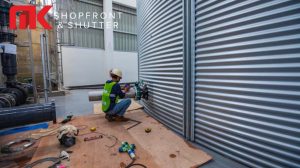As London’s winter arrives with frosty winds and relentless rain, your shopfront shutters take the full brunt of the season. Whether you have a café in Camden or a boutique in Brixton, it is important to keep your shutters in top condition prior to winter weather arriving. Failure to do so can result in stiff mechanisms, water entry, and even expensive shutter repair down the line.
This detailed winter maintenance guide by MK Shopfront & Shutters, London’s experts in Shopfront and Shutter services, assists you in preparing for the coming months so your business facade is kept safe, efficient, and aesthetically pleasing.
Pre-Winter Checklist For Shopfront Shutters
1. Check for Structural Damage or Rust
Prevent cold weather from setting in by conducting a visual check on your roller or shopfront shutters. Examine:
- Dents, corrosion spots, or misalignment on the slats.
- Leaks on the side rails or openings that may allow water to enter.
- Paint peeling or rust, usually the result of extended exposure to moist air.
Rust that goes unchecked can easily compromise security in London’s rainy climate by weakening metal shutters. When you see early warning signs, have preventative shutter repair done right away so problems don’t escalate on cold winter rainstorms.
2. Lubricate Moving Parts
Low temperatures can seize or stiffen metal components, resulting in jerky or noisy movement. Apply a light, cold-resistant lubricant to the following before winter:
- Tracks and side runners.
- Manual shutter hinges and rollers.
- Gear mechanisms in automatic systems.
Avoid generic or heavy oils, which could solidify at low temperatures. Well-lubricated components ensure smooth operation and extend the life of your shutter system all season long.
3. Inspect Weather Seals and Bottom Bars
Weather seals are your initial protection from rain and drafts. Check the bottom rubber seal and vertical side gaskets to make sure they aren’t cracked, stiff, or brittle.
Faulty seals may let moisture creep inwards, resulting in internal condensation and even motor faults in motorised roller shutters. A periodic seal check—often part of a professional shutter fit service—is enough to avoid these problems and keep your home warm during winter runs of cold weather.
4. Clean Tracks and Drainage Channels
Leaves and other debris fall everywhere in London streets in autumn. If these pile up in your shutter tracks or drainage channels:
- They may jam the mechanism, causing uneven opening and closing.
- Water standing on top may freeze, trapping shutters overnight.
Clean blockages using a soft brush or compressed air to maintain smooth functioning all winter long. Cleaning regularly not only helps avoid damage but also prevents moisture-rust-causing likelyhood.
5. Test the Electrical System (for Automatic Shutters)
If your shopfront is operated by electric roller shutters, check the motor function prior to severe weather. Problems with wiring or damp circuit faults are usually revealed in cold weather. Ensure that you:
- Listen for grinding or delay on operation.
- Check that sensors and remote systems respond as expected.
- Inspect for condensation within control boxes.
If performance is poor, call a specialist technician at MK Shopfront & Shutters to inspect right away electrical parts that are especially vulnerable to dampness and frost.
6. Weatherproof the Outside Finish
Rain, frost, and fluctuating London temperatures take a toll on painted or powder-coated shutter surfaces. A quick winter weatherproofing routine can extend their lifespan significantly.
- Wash shutters with a mild detergent solution to remove grime and pollutants.
- Dry thoroughly, then apply a protective wax or spray coat recommended for metal finishes.
- Consider re-painting or powder-coating older shutters before winter to create a fresh weatherproof barrier.
A professionally finished shutter resists corrosion while maintaining your storefront’s appeal critical for customer footfall in quieter winter months.
7. Insulate the Shopfront and Shutters
Energy efficiency is of key importance during London winters, particularly for high-cost-heating businesses. Insulated shopfront systems or roller shutters can:
- Stop cold air from escaping.
- Keep heat overnight when closing up.
- Lower your overall energy costs while safeguarding stock and displays.
If existing shutters are not insulated, replace with new aluminum system specifically for temperature regulation. This minimal investment is rewarded by lower bills and improved comfort for staff and visitors.
8. Thoroughly Clean Glass and Frame Sections
For stores with aluminum or glass frontages, grime buildup can reduce natural light and make condensation worse during frosty months. Include the following in your winter maintenance:
- Clean glass panels weekly with non-abrasive cleaners.
- Wipe down aluminum frames to remove moisture and salt traces.
- Check seals around glass panels to avoid fogging or leaks.
Shine and transparency are vital for London retail environments—they convey professionalism and trust even during gloomy winter days.
9. Check Operation After Severe Frost or Snow
Cold snaps freeze shutters temporarily, particularly when morning dampness becomes overnight ice. Do not force a shutter open if it resists it may tear the mechanism or crack pieces.
Instead:
- Melt frost gently with warm air or de-icing fluid.
- Ensure all moving parts are dry before use.
If freezing is a regular occurrence, question your repair supplier regarding anti-freeze lubrication or weatherproof seals to avoid repetition.
A simple prevention measure now will conserve a significant shutter repair down the line.
10. Arrange for a Professional Check-Up Prior to Peak Winter
There is no replacement for professional maintenance. A pre-winter check-up by a qualified team ensures that hidden problems such as minute misalignment or tension imbalance don’t become serious.
MK Shopfront & Shutters technicians check every aspect of your installation, such as:
- Motor calibration and remote system checks.
- Balance and weight distribution on roller shutters.
- Secure fixing points for safety and durability.
If necessary, they’ll do maintenance or replacement recommendations in the field perfect for companies that can’t lose time during peak holiday trading.
Also Read– Maintenance Tips for Your Shopfront
Why Winter Maintenance is Important for London Businesses
London’s combination of rain, frost, and unpredictable temperature falls can weaken even top-quality shutters. Regular inspection and routine servicing guarantee:
- Longer shutter lifespan.
- Reliable operation throughout harsh conditions.
- Adversity protection against water entry, vandalism, and energy loss.
Additionally, keeping your shopfront looking good and in working order ensures your business continues to maintain its image and attractiveness during the cold winter months. Customers have greater confidence in prospering well-displayed storefronts particularly at winter spending highs.
Conclusion
Your shutters and shopfront are long-term investments that require year-round maintenance, particularly prior to winter hitting. Annual inspections, on-time shutter repair, quality shutter installation, and hard-wearing shopfront installation can help your business avoid the costs and downtime when winter sets in.
We at MK Shopfront & Shutters specialize in getting London businesses season-ready. Our skilled staff delivers repair, installation, and maintenance services tailored to meet your property’s requirements combining cutting-edge security solutions with visual appeal to boost your brand’s visibility.
Also Read- Shopfront Ideas For Fresh Look
FAQs
1. How often should I clean my shopfront shutters in winter?
Shutters should be cleaned at least every two weeks during winter. Salt, slush, and road grime from London’s streets can corrode the exterior finish. Use mild detergent and avoid abrasive cleaners to protect painted or powder-coated surfaces.
2. What type of lubrication is best for roller shutters in cold weather?
Use silicone or lithium-based low-temperature lubricants, as these remain effective and fluid in freezing conditions. Avoid thick oils that can harden and cause stiffness in the system.
3. Can frozen shutters be opened manually?
No, forcing frozen shutters open can damage the motor, slats, or tracks. Instead, gently thaw with mild heat or de-icing spray, then wipe dry before use. If the shutter is still stuck, contact an expert for safe inspection and shutter repair.
4. When should I book professional winter maintenance for my shutters?
It’s best to schedule inspections twice a year—ideally in late autumn and early spring. Pre-winter servicing ensures your shutters are lubricated, sealed, and fully functional before freezing weather sets in.
5. What are the most common winter-related shutter problems in London?
The most frequent issues include jammed tracks, motor freezes, rust on side rails, split seals, and slow movement due to hardened grease. Regular inspection and timely shutter repair prevent these from becoming costly setbacks.





